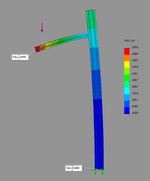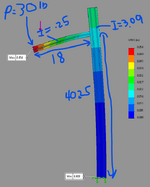fortjp500
Automotive
- Jun 22, 2021
- 22
Good morning, I'm struggling to find the theory of how to validate the deflection of two pieces of 8020 aluminum extrusion that are assumed to be fixed to each other and fixed to the ground. I think I'm going about it wrong, but when I calculate the static beam deflection of a point load applied to the end of the smaller piece and then calculate the static deflection of the vertical post from the moment that is being applied I can't get to the FEA result.



